The trampoline has always been the favorite outdoor sport for children, teenagers and adults. They do provide a great way to make children happy while maintaining their shape and vitality.
Having a trampoline in your backyard can provide everyone in your family with a chance to exercise, and it’s also very interesting.
There are a number of types and styles for consumers to choose from making it [slightly] confusing to determine the differences between them.
The following will provide you with all that you will need to know in order for you to choose the best option for your lifestyle, yard and family.
Common Shapes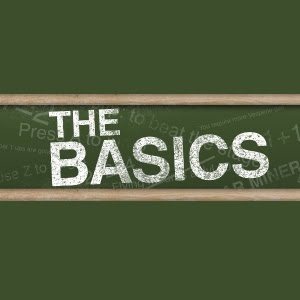
In regards to trampolines, there are basically two main shapes for you to choose from, which are rectangular and round.
Each of them is suited for different uses.
Depending upon your particular needs, one shape may be better suited for you above the other. With that being said, you will need to access your needs via the following questions:
- Will this be used just for play?
- Do I want my child/ren to be able to exercise as well?
- How much space can I dedicate to this?
- What is my overall budget?
These very simple questions will allow your search window to be narrowed to include precisely what it is you will need in a trampoline.
Rectangular
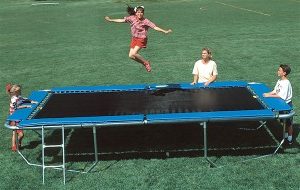 Trampolines that are rectangular tend to be the optimal choice of those that are serious trampolinists as opposed to those that simply desire something for their children to merely jump about on.
Trampolines that are rectangular tend to be the optimal choice of those that are serious trampolinists as opposed to those that simply desire something for their children to merely jump about on.
This is a trampoline shape that is more than ideal for those that have children that are into gymnastics and are in need of a practice area.
A rectangular trampoline will provide a jumper with a rebound that is more powerful delivering them the proper amount of height that is needed for most all gymnastic moves.
Due to the rebound power that this type of trampoline is able to deliver, there should NEVER be more than one person using it at a time.
Should the unit be used for the practice of gymnastics moves, there should be two spotters (one on either side) present at all times for safety reasons.
There are no tents or enclosures available for rectangular trampolines due to the fact that they tend to be more for specialized usage.
You will also need to note that they are, on average, more expensive than their round counterparts.
Round
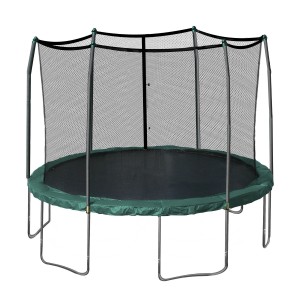 Round trampolines are the most popular choice due to the fact that most consumers buy them for their children to simply play around on them.
Round trampolines are the most popular choice due to the fact that most consumers buy them for their children to simply play around on them.
The round shape of the unit delivers a much easier rebound as well as the fact that more than one person can safely jump about on them.
Typically, round trampolines are measured in diameter and can be quite large (if desired or needed).
Trampolines that are extremely large have the ability to safely accommodate upwards of three jumpers at a single time.
This type of trampoline comes equipped with safety tents and/or enclosures regardless of their size. The enclosures and tents provide those jumping with an added level of safety during play.
Round trampolines tend to be less expensive than rectangular trampolines. Additionally, they are readily available because of their high demand.
What is the Best Size?
As a rule of thumb, you should always purchase the largest trampoline that you have the space and budget for. With that in mind, note the following:
- Round trampolines have 4 basic size options: 8, 10, 12 & 14 feet in diameter (with 1 feet being the most common)
- Rectangular trampolines: Are available in an array of dimensions that include custom designs.
Spring Free
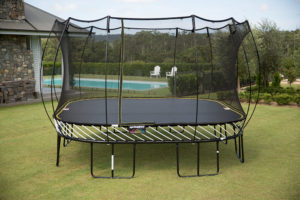 This is a fairly new trampoline design. One of the greatest safety concerns in regards to the units, is falling through the springs.
This is a fairly new trampoline design. One of the greatest safety concerns in regards to the units, is falling through the springs.
This form of trampoline has successfully eliminated this issue and concern.
Do note that the lack of springs does not make this form of trampoline injury proof, it simply addresses a major issue within the arena.
Spring Free trampolines are more expensive than their traditional counterparts, but the plus side to the cost is the fact that you will never have to replace a spring.
Trampoline Pads
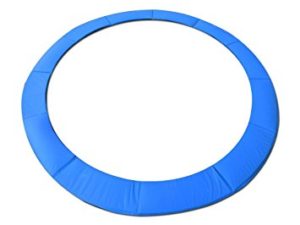 One of the very first safety measures added to trampolines was that on safety padding that covered the unit’s springs.
One of the very first safety measures added to trampolines was that on safety padding that covered the unit’s springs.
The pads are constructed of foam and either tie to the frame or connect via Velcro.
The pads are used in order to prevent pinching from the springs as well as falling through them.
Unfortunately, trampoline pads tend to deteriorate rather quickly and will need to be replaced often. They are also prone to sliding.
In Conclusion
With this information, you will be able to embark on purchasing the proper trampoline for your family, space and budget.